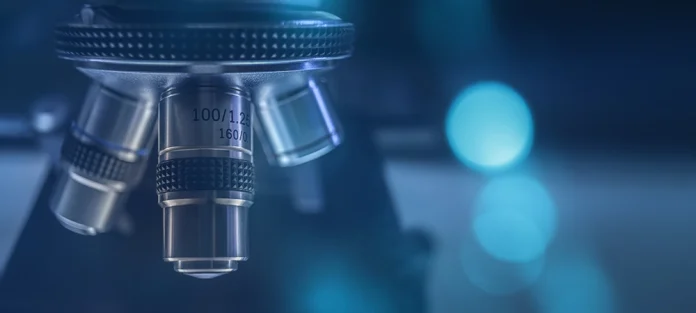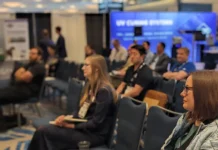By James R. Bolton, Bolton Photosciences
Prior to 1998, ultraviolet (UV) disinfection of drinking water was not popular because of a perception that UV treatment was not effective for waters contaminated with protozoa, such as Cryptosporidium, and did not seem to have equivalent advantages as chlorination and ozonation. In 1997-1998, a group of dedicated scientists and engineers collaborated to achieve a remarkable turnaround in this perception. This article documents this story, culminating in a presentation 25 years ago at the June 1998 American Water Works Association (AWWA) Convention in Dallas, Texas.
Early UV disinfection research suffered from a lack of multi-disciplinary teams that could effectively deliver and quantify the UV dose through their understanding of UV photonics, as well as effectively perform the microbiological techniques needed to assay the viability of the organisms exposed to UV light. The early explanation given for studies that reportedly concluded that UV light was ineffective at practical doses for protozoan cysts attributed this to proteins in the cysts or oocysts membrane blocking the UV light and preventing it from reaching the interior of the cell, where it would bring about damage to the nucleic acids vital to cell viability. However, this explanation later was proven to be false, since proteins in the oocyst walls do not absorb UV in the wavelength range where nucleic acids absorb; hence, the UV passes right through the oocyst wall to be absorbed by DNA in the nucleus.
In early 1997, Sam Stevens and Bertrand Dussert at Calgon Carbon (UV division) persuaded upper management to initiate a research project examining the UV sensitivity of Cryptosporidium using an infectivity assay (feeding oocysts to neonatal mice). Sam Stevens negotiated a contract with Jennifer Clancy (Clancy Environmental Consultants) in Vermont to carry out this research project. Calgon Carbon built a collimated beam apparatus, and Jim Bolton went to Vermont to train Zia Bukhari and Tom Hargy on the collimated beam testing protocol. A test was conducted in which oocysts were exposed to various UV doses. The oocysts then were shipped to Tucson, Arizona, where Marilyn Marshall and her group at the University of Arizona fed the oocysts to neonatal mice. The results were astonishing – even at the lowest UV dose (lowest 41 mJ/cm2), no mice (0/25) were infected. Clearly the Cryptosporidium oocysts were very sensitive to UV.
Stevens then proposed that Calgon Carbon fund a major R&D project involving participation in the new USEPA Environmental Technology Verification (ETV) program involving manufacture of a new line of medium-pressure UV reactors (Sentinel). Cartwright, Olsen & Associates was chosen to oversee the project. A 6 x 1 kW Sentinel prototype was manufactured at the Toronto Calgon Carbon plant, supervised by Keith Bircher and Steve Cater, while the overall project was managed by Stevens (business) and Bolton (research). Phil Olsen (Cartwright, Olsen & Associates), an USEPA/NSF-accepted ETV Field Testing Organization, held primary responsibility for this study, including the resultant Performance Verification Report (EPA, 1999) and its defense throughout USEPA’s peer review process.
In Spring 1998, the Sentinel prototype reactor was installed at the Mannheim Water Treatment Plant in Kitchener, Ontario, Canada. Tom Hargy (Clancy Environmental Consultants) travelled to Kitchener with a suspension of oocysts. These were pumped into the water line at several flow rates and UV powers to achieve a range of UV doses. The oocysts were trapped on filters, sent to Vermont where the oocysts were extracted and then sent to Arizona for mice infectivity tests. All microbial challenge protocols were overseen by Debra Huffman (University of South Florida). The results were astonishing – even at the lowest UV dose (19 mJ/cm²), only 1/25 mice were infected.
Bolton drafted a paper for the AWWA Convention and presented it in early June 1998 (Bolton et al. 1998). Word had got around that this presentation was very important, so the lecture hall was packed. After the presentation, Jim Malley (University of New Hampshire) stood up and told the audience that due to the Cryptosporidium outbreak in Milwaukee, Wisconsin, and the pending federal regulations – which now are known as the LT2ESWTR (2006) – that this finding, if verified, would change the future of the UV industry, and he was right. From 2000 on, UV treatment facilities were installed in many drinking water facilities of large cities, such as New York, Los Angeles, Chicago, Seattle, San Francisco, Vancouver, Winnipeg and many others around the globe. In addition, this finding and its implications were the major driving force behind the formation of the International UV Association (IUVA) in 1999.
This research effort would not have been possible without the collaboration of so many multi-disciplinary scientists and engineers. The principals are named in this article, but there were many others playing supporting roles. This article celebrates their extraordinary contribution to the UV industry.
Resources
- Bolton, J.R., Dussert, B., Z. Bukhari, Hargy, T.M., and Clancy, J.L. (1998) Inactivation of Cryptosporidium parvum by Medium-Pressure Ultraviolet Light in Finished Drinking Water, Proceedings AWWA 1998 Annual Conference, Dallas, TX, AWWA, Denver CO, Vol A, pp 389-403. This presentation paper was later published as Bukhari et al. (1999).
- Bukhari, Z., Hargy, T.M., Bolton, J.R., Dussert, B. and Clancy, J.L. (1999), Medium Pressure UV Light for Oocyst Inactivation, J. AWWA, 91(3), 86-94.
- EPA (1999, May) Environmental Technology Verification Report NSF International Ann Arbor Michigan Inactivation of Cryptosporidium Parvum Oocysts in Drinking Water Calgon Carbon Corporation’s Sentinel Ultraviolet Reactor, https://nepis.epa.gov/Exe/ZyPURL.cgi?Dockey=P10012XA.txt
Note: Marilyn Marshall should have been listed as an author of the first two references.
James R. Bolton, Bolton Photosciences, can be reached at jbolton@boltonuv.com or via phone at 780.906.1012.






